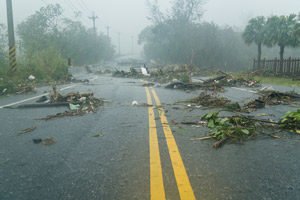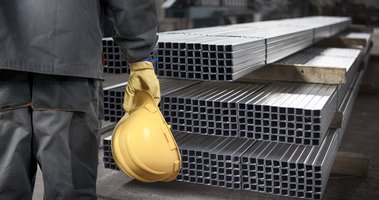Harvey, Irma, Jose, Katia, Maria... the list is long, and could still grow.
These are the names of some of the strongest hurricanes ever recorded in the Atlantic Ocean... and they're all from this season.
September may have been the worst month for hurricanes... ever.
The devastation has been almost beyond comprehension. Mass evacuations, flooding, and ultra-high winds caused power, water, food, and gasoline shortages that have affected millions of people.
The destruction to homes, commercial buildings, roads, and bridges has been catastrophic, and the damage to cars, trucks, and boats is beyond repair.
As you can imagine, the reconstruction effort is going to be of goliath-sized proportions, while the companies in charge of this undertaking are set up for immense profits.
Harvey, Irma, and Maria Caused $360 Billion in Damages
Despite a host of forerunners in the preceding months, this year's hurricane season really got going in a truly remarkable way on August 17th, with Hurricane Harvey
 In its wake, Harvey left 57 dead and dumped about 27 trillion gallons of rain on Texas and Louisiana in just six days.
In its wake, Harvey left 57 dead and dumped about 27 trillion gallons of rain on Texas and Louisiana in just six days.
Texas Gov. Greg Abbott warned that around $150 - $180 billion may be needed to help rebuild his state. If that's the case, and it's looking very likely, Harvey will handily beat the previous record set by Katrina, in New Orleans, at $110 billion.
And that's just Harvey...
[mmpazkzone name="in-story" network="9794" site="307044" id="137008" type="4"]
This Could Make Big Oil Obsolete: One gallon of this new fuel could produce enough energy to power a car for 42,325 miles. It's being hailed by many experts as energy's "Holy Grail." Read more...
No sooner was Harvey petering out that Tropical Storm Irma started forming on August 30th.
Antigua, Barbuda, St. Martin, Anguilla, St. Kitts and Nevis, and the U.S. and British Virgin Islands were directly in her path, with the destruction so bad that Barbuda has been deemed "uninhabitable."
Irma went on to cause major damage in the Dominican Republic, Turks and Caicos, Cuba, and the Bahamas. Next, she visited the Florida Keys and moved up the state's Gulf Coast.
Irma was followed by Hurricanes Jose, Katia, Lee, and finally, Maria.
Maria pummeled Puerto Rico, which endured its strongest storm in 85 years, suffering heavy damage to the energy grid and an island-wide power outage.
Early cost estimates to rebuild Puerto Rico have been pegged between $40 billion and $80 billion.
Restoration efforts of the affected areas are already underway in Texas, Louisiana, and Florida, with Puerto Rico soon to follow.
The smart money is moving right now - before all the contracts pile up.
The companies that furnish equipment, materials, and services for this gargantuan reconstruction effort will see a strong boost to their businesses.
Here are the three that I think everyone has to be in in this situation - including one that's good for a quick 45% gain.
Reconstruction Gains Times Three
U.S. Concrete Inc. (Nasdaq: USCR) produces and sells ready-mixed concrete, aggregates, and concrete-related products and services for the construction industry in the United States. Its main customers are subcontractors, general contractors, government agencies, property owners and developers, architects, engineers, and home builders.
Through its operating companies, USCR serves major construction markets in the United States in two business segments: ready-mixed concrete and aggregate products. U.S. Concrete's products and services are provided from operating companies located in north and west Texas, northern California, New Jersey, New York, Washington, D.C., and Oklahoma.
U.S. Concrete has 3,000 full-time employees and a market cap of $1.2 billion. Although its trailing P/E is high, at 48.5, its forward P/E is a very attractive 14.95. Return on equity is over 16%, and although it pays no dividend, its quarterly revenue is growing at a healthy clip of 23.6%.
The company has a ton of experience with major projects, including a NYC-area bridge, Yankee Stadium, and more. With the company's head office in the Dallas area, its location should be a key advantage in securing a good portion of the Lone Star State's rebuilding cement and aggregate contracts.
With that in mind, I expect USCR to be up by 40% over the next 12 months.
Along with concrete, the rebuilding effort is going to require massive amounts of steel. I expect the United States Steel Corp. (NYSE: X) to get a good portion of this business.
Many sectors of the economy have been affected, and they all require some amount of steel to replace or repair the heavy damages. Some estimates of the number of automobiles on dealership lots alone needing replacement range from 150,000 to 200,000.
What's more, another half a million or so other cars used by individuals, businesses, and institutions will require replacement. All of these require steel, as well.
Founded in 1901, the United States Steel Corp., headquartered in Pittsburgh, Pa., serves the construction, container, appliance, electrical, oil, gas, and petrochemical markets, amongst others. We also know that the current administration is big on "America First," meaning U.S.-sourced products will likely get favorable treatment when it comes to any federal money.
United States Steel employs nearly 30,000 people, has a $4.4 billion market cap, and its own low P/E down near 11.5. Its dividend is minor, at 0.8%, but quarterly revenue growth is healthy at 22%, with plenty of cash in the till.
I think we could well see a 45% gain in United States Steel in the next year.
 Finally, timber also stands to benefit in a big way as the rebuilding effort goes full steam. My pick in this sector is Weyerhaeuser (NYSE: WY). WY is a $26 billion timber powerhouse, with operations across a number of U.S. states. The company, founded in 1900 and headquartered in Seattle, Wash., employs 10,400 people and is set up as a real estate investment trust, making it more tax-efficient.
Finally, timber also stands to benefit in a big way as the rebuilding effort goes full steam. My pick in this sector is Weyerhaeuser (NYSE: WY). WY is a $26 billion timber powerhouse, with operations across a number of U.S. states. The company, founded in 1900 and headquartered in Seattle, Wash., employs 10,400 people and is set up as a real estate investment trust, making it more tax-efficient.
Weyerhaeuser operates under four business segments: timberlands, wood products, cellulose fibers, and real estate. The company owns timberlands mainly in the United States and has long-term licenses in Canada. WY manufactures wood and specialty cellulose fibers products and develops real estate mainly as a builder of single-family homes.
Many of its operations are located in Louisiana, Arkansas, Mississippi, and Alabama, all of which were either lightly affected or completely unaffected by the hurricane, yet are geographically close to Texas.
WY earns hefty profit margins of 14%, has $6.8 billion in revenue, and a respectable quarterly revenue growth of 8.8%. The company holds $700 million in cash and pays a generous 3.7% dividend.
I expect the next several quarters will show strong growth as Florida, Texas, Louisiana, and even the affected parts of the Caribbean stock up on timber for their drawn-out rebuilding efforts.
Weyerhaeuser is ideally located and strategically set up to get a good share of that business. Look here for strong outperformance that could bring gains of 40% or better in the next 12 months.
As recovery picks up steam, these stocks won't be inexpensive forever.
Energy's $48 Trillion Holy Grail: A shocking discovery has unlocked a 36,000-year supply of free energy. Not only is this fuel source endless, it's ready to use immediately. The U.S. Department of Defense just invested $7 billion in a single day, igniting an early stage "energy boom" that will likely mint millionaires at a dizzying clip. Find out exactly how to play it here...
Follow Money Morning on Twitter @moneymorning, Facebook, and LinkedIn.


